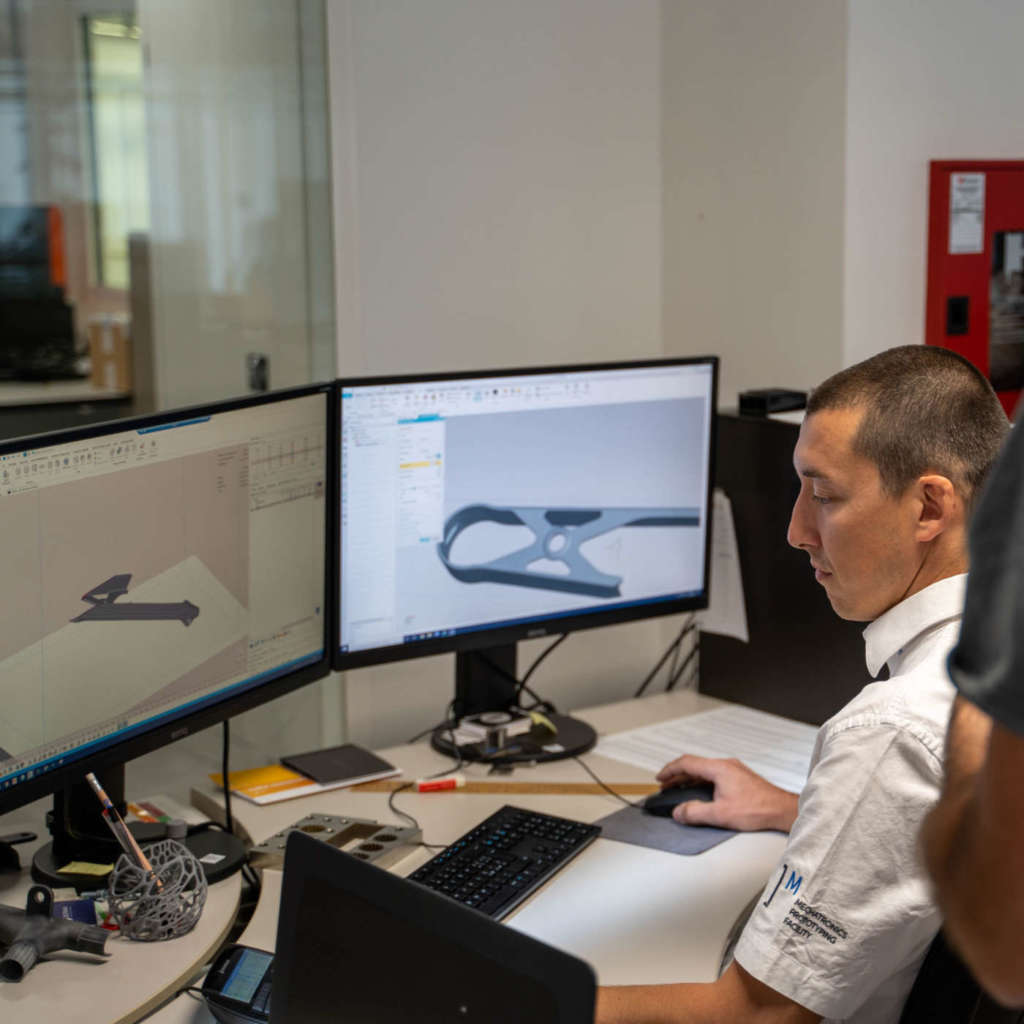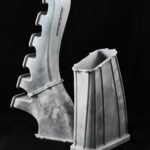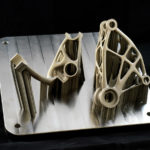Construction speed, precision, high technical skills, state-of-the-art machinery and the possibility of creating even single parts, disengaging from the logic of mass production: if on circuits around the world aboard the motorcycles of Gresini Racing and Team Trentino Gresini MotoE there are components designed and created by ProM Facility, it is precisely for these reasons.
The partnership between the Romagna-based Team Gresini racing team and the prototyping and 3D printing laboratory of Trentino Sviluppo, the system company of the Autonomous Province of Trento that deals with territorial development, was launched at the beginning of the year and is involving three specialised technicians, who are working on the creation of components for racing motorcycles using metallic 3D printing, polymer printing and laser cutting.
Polymer 3D printer: lever guard and chain guard
Present in the ProM Facility for the past two years, the Multi Jet Fusion (HP MJF 4200) polymer 3D printer (HP MJF 4200) due to its versatility and precision is highly exploited for various types of machining. It allows pieces of any shape to be made from Nylon PA12, in small and medium series.
The maximum allowable working size is 380 × 284 × 380 mm, at a resolution of 1200 dpi. The precision of the objects is therefore very high, a quality that is combined with an excellent printing speed.
In fact, the MJF 4200 makes it possible to achieve the mass production printing of 300-700 parts per week, which are immediately ready for use, since they do not require additional cleaning and post-processing work, as is usually the case with other types of 3D printing. Speed and precision: the perfect combination to meet the stringent timelines and difficult demands of the racing world.
Team Trentino Gresini’s first commission for ProM Facility was to make the lever guards for the motorcycle of Matteo Ferrari, the reigning MotoE world champion. A part that had to be lightweight, aerodynamic and durable. The obvious choice was to use a polymer printer and Nylon PA12 that has excellent mechanical qualities and provides excellent resistance to fatigue and weathering, so much so that it is able to maintain its characteristics up to a temperature of 180°C. Four different models of lever guards (for both the right and left side of the handlebars) were created so that the team’s technicians could test them in the University of Perugia’s wind tunnel and thus choose the most effective one. The tests gave surprising results, recording a 30 percent increase in aerodynamic performance compared to the original components.
Seeing the success of the lever guards, another challenge arrived at the Polo Meccatronica laboratory in Rovereto, again from Team Trentino Gresini MotoE. The request was to modify the chain guard, that is, the guide that serves to hold the chain in place so that it does not scrape against the frame, because the standard part purchased did not fit the bike of the Ferrari champion. Again, the timing was tight because in a few days the team would leave for preliminary testing at the Jerez de la Frontera circuit. ProM Facility technicians used Creaform’s MetraSCAN 3D, a 3D scanner that features 15 laser crosses and a high measurement speed to deliver three-dimensional scans very quickly.
The most complex part was later the CAD reworking of the model obtained, which was carried out using Geomagic Design X, an advanced solid modelling software that allowed to modify the geometry of the part according to the requirements. This was delicate and complex work, which kept the technicians busy for a whole day. Once the correct model was obtained, they finally moved on to Nylon printing with the MJF 4200. Barely three days later, Ferrari’s Energica Ego Corsa was already sporting a new chain guard.
Metal 3D printing: aluminum coupling
Not just electric motorcycles and not just Nylon. Gresini Racing also competes in other categories (Moto Gp, Moto 2, and Moto 3), and the third job commissioned to ProM Facility was precisely a metal item for a gasoline motorcycle. It involved creating an aluminum coupling (AISi10Mg) for the jointing of the cooling pipes onto the engine head. An interesting and complex workmanship that took advantage of SLM (Selective Laser Melting) technology.
The SLM uses a laser beam to melt metal powder in a very precise manner, making entire three-dimensional objects section by section. This well-established technique has pioneered the construction of parts never conceived and designed before because they were unfeasible with conventional technologies. In recent years, moreover, it has achieved an operating speed that has allowed it to be competitive not only in the field of prototyping but also in the production of small series (hundreds or thousands of pieces).
The coupling produced in the ProM Facility was designed to then be finished on the lathe, as needed, in the Gresini Racing laboratory. It was impossible, however, for the Romagna technicians to fasten it into the machine because it was a curved piece and had no points where it could be anchored.
A grapple was then designed and produced using the polymer 3D printer to keep the coupling centered on the machine’s spindle axis, so that the customer could finish the part independently, thereby achieving the desired dimensions and tolerances. Satisfied with the result, the Gresini technicians requested another identical part for the spare bike.
Laser cutting: handlebar adjuster
Each rider has a custom set-up of the handlebars on their bike, the two parts of which can be adjusted independently.
To do this requires a tool, the handlebar adjuster, which is made up of three components and which Gresini Racing commissioned from ProM Facility because those on the market have dimensions that do not fit their team’s bikes. The request was to produce two sizes for different bikes (and riders), for Moto 2 and Moto 3 respectively.
Again, the material to be worked on was aluminum. Polymer printing was used to make the bushings, while the imposing (18-meter-long) BLM LC5 was used for machining the foils and marking. Built at the Adige-BLM Group plant in Levico Terme (Trento), it is an innovative laser cutting machine that can cut both tube and sheet metal, ensuring excellent performance even on highly reflective metals such as copper, aluminum and brass.
A SISMA marker was then used for marking the parts on which the degrees of inclination of the handlebar are marked, somewhat like in a protractor. Today the machine is now located in the brand new Live Demo SMACT laboratory in Rovereto, also established in Polo Meccatronica spaces, where it will be completed and inaugurated in spring 2021.
A turn-key service
The main feature that emerges from these works is the variety of techniques, skills and instrumentation used in their realization. Polymer and metal printing, laser cutting and marking, 3D scanners, design. All in one specialized center, with technicians who can quickly and professionally ensure an overall view of the problem to be solved.
And it is precisely this that makes ProM Facility the most advanced mechatronic prototyping laboratory in Italy: the ability to offer companies of the mechatronics supply chain an integrated platform for the design, development, implementation, verification and validation of production systems and processes, with the ability to meet customer requirements internally, without necessarily having to turn to external entities.
A set of technologies and skills that also allow for the creation of unique, non-series pieces. An added value in a market where, increasingly, small productions are often not even considered.
The future of ProM Facility
Three years after starting operations at Polo Meccatronica in Rovereto, ProM Facility is consolidating its position as a national center of excellence for the development of mechatronic prototypes to support innovative product development. Its strength lies in its ability to concentrate different enabling technologies of Industry 4.0 such as 3D printing, artificial intelligence, smart manufacturing and control electronics in a single laboratory.
The sectors in which it is interfacing most strongly are automotive (particularly racing), avionics/aerospace (particularly the design and production of special parts for drones and satellites), and biomedical (robotic joints, 3D printed prosthetics, reconstruction of anatomical parts using 3D images).
Speaking of new things, the lab is currently putting into operation a new X-ray tomography scanner that allows to photograph the inside of 3D printed components, even in metal. This offers the great advantage of being able to measure and examine them internally without having to touch or damage them.
Further investment efforts are planned in upgrading metal 3D printing, in developing materials for special applications and in artificial intelligence, also in synergy with the new Competence Center of the University of Trento and Bruno Kessler Foundation that will establish its robotics and industrial automation laboratory right inside Polo Meccatronica, next to ProM Facility.
The laboratory stands as a link between applied research and advanced manufacturing industry. The technological development and specialized training offered always benefits companies and gets its sustenance from the investment in research expertise present in the Trentino region.
In fact, the ProM Facility itself is the result of a partnership with the University of Trento, Bruno Kessler Foundation and Confindustria Trento, with whom Trentino Sviluppo has signed an agreement that provides, among other things, highly qualified expertise and personnel.




